Interactions between cognitive disequilibrium, interactivity with instructional videos, and learning
IF 10.5
1区 教育学
Q1 COMPUTER SCIENCE, INTERDISCIPLINARY APPLICATIONS
引用次数: 0
Abstract
The use of videos as instructional tools has increased dramatically in recent years. However, most research on student learning from videos has been conducted in clinical settings and has not explored the mechanisms that underlie connections between students' interaction with videos and their learning. This study explores the relationship between students' experiences of cognitive disequilibrium–operationalized in terms of Harel's (2013) theory of intellectual need–their use of video playback controls, and their learning from instructional videos in introductory calculus classes at the undergraduate level. The data reveal that students who paused or skipped backward in the video were more likely to demonstrate learning, and that this effect was stronger for students who exhibited lower background knowledge. Similarly, students who experienced cognitive disequilibrium were more likely to improve their performance. However, when we controlled for temporal interactions, cognitive disequilibrium was no longer a significant predictor of enhanced learning, which suggests that the experience of disequilibrium could underlie students' interaction with and promote their learning from mathematics instructional videos.
认知失衡、教学视频互动与学习之间的互动
近年来,视频作为教学工具的使用急剧增加。然而,大多数关于学生从视频中学习的研究都是在临床环境中进行的,并没有探索学生与视频互动和学习之间联系的机制。本研究探讨了学生认知失衡体验(根据Harel(2013)的智力需求理论进行操作)与视频播放控制的使用,以及他们在本科水平微积分入门课程中学习教学视频之间的关系。数据显示,在视频中暂停或向后跳的学生更有可能表现出学习,而且这种效果在背景知识较低的学生身上表现得更强。同样,经历过认知失衡的学生更有可能提高他们的表现。然而,当我们控制时间互动时,认知失衡不再是提高学习的重要预测因素,这表明认知失衡的经历可能是学生与数学教学视频互动的基础,并促进他们从数学教学视频中学习。
本文章由计算机程序翻译,如有差异,请以英文原文为准。
求助全文
约1分钟内获得全文
求助全文
来源期刊

Computers & Education
工程技术-计算机:跨学科应用
CiteScore
27.10
自引率
5.80%
发文量
204
审稿时长
42 days
期刊介绍:
Computers & Education seeks to advance understanding of how digital technology can improve education by publishing high-quality research that expands both theory and practice. The journal welcomes research papers exploring the pedagogical applications of digital technology, with a focus broad enough to appeal to the wider education community.
 求助内容:
求助内容: 应助结果提醒方式:
应助结果提醒方式:


